Last Updated on December 7, 2024 by Kittredge Cherry
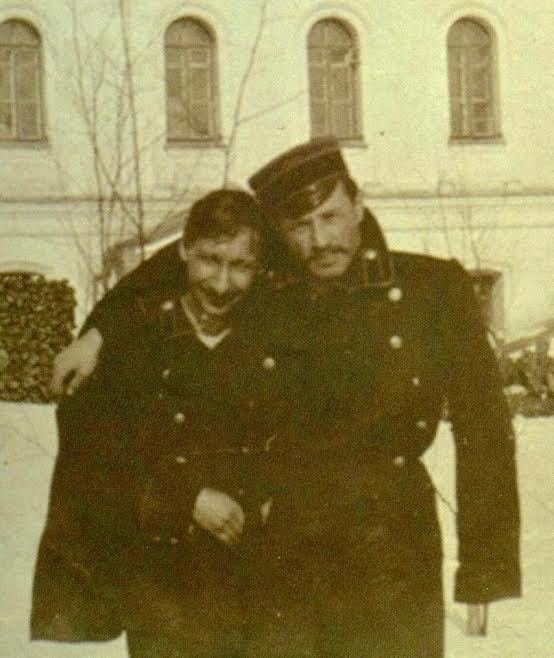
Pavel Florensky was a Russian Orthodox priest and scientist who wrote a groundbreaking theology of same-sex love in the early 20th century. He was executed on Dec. 8, 1937 on false charges as part of a Soviet anti-religious campaign.
Florensky (1882-1937) is recognized as one of the greatest Orthodox theologians of the 20th century. His major theology book is arranged as a series of letters addressed to an unnamed “friend and brother,” who turns out to be his beloved friend and seminary roommate, Sergei Troitsky.
“It comes as a surprise to my colleagues when I mention that the modern world’s first Christian theology of same-sex love appeared in Moscow in 1914,” writes Canadian scholar and Orthodox Christian Giacomo Sanfilippo in a controversial new series of articles about Florensky’s life and work.
Florensky’s writing on the spiritual value of same-sex friendship is indisputable, as is his own devoted friendship with Troitsky. He also wrote about the ancient rite of adelphopoiesis (known as brother-making or same-sex union).
But critics object to how Sanfilippo illuminates the homo-romantic possibilities in Florensky’s life and builds on his work to develop a theology of “conjugal friendship” akin to same-sex marriage.
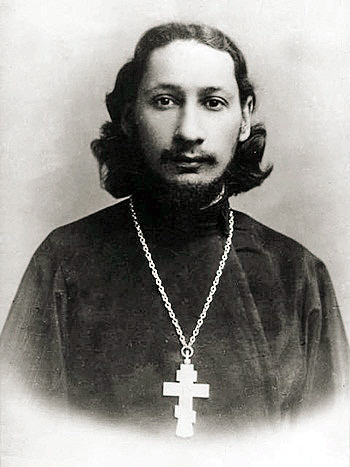
Pavel Florensky (Wikipedia)
Florensky also excelled as a mathematician, physicist, engineer, inventor, linguist, art historian, and philosopher, so he is considered a polymath or Renaissance man comparable to Leonardo Da Vinci. To some he is also a saint and martyr because Florensky was sent to forced labor camps and executed during the Soviet anti-religious purges of the 1930s. Nobel Prize-winning Soviet dissident Alexandr Solzhenitsyn called Florensky “perhaps the most remarkable person devoured by the Gulag” in his landmark book “The Gulag Archipelago.”
Florensky’s theology of same-sex love
 Florensky’s major book, “The Pillar and Ground of the Truth: An Essay in Orthodox Theodicy in Twelve Letters”, is structured as 12 letters to a friend. His roommate Troitsky was the original beloved friend to whom the letters are addressed. But the friend is kept anonymous.
Florensky’s major book, “The Pillar and Ground of the Truth: An Essay in Orthodox Theodicy in Twelve Letters”, is structured as 12 letters to a friend. His roommate Troitsky was the original beloved friend to whom the letters are addressed. But the friend is kept anonymous.
The back-cover blurb helps hide the real-life friendship behind the book by focusing on a spiritual interpretation: “The book is a series of twelve letters to a ‘brother’ or ‘friend,’ who may be understood symbolically as Christ.” A deeper look reveals little-known LGBTQ history.
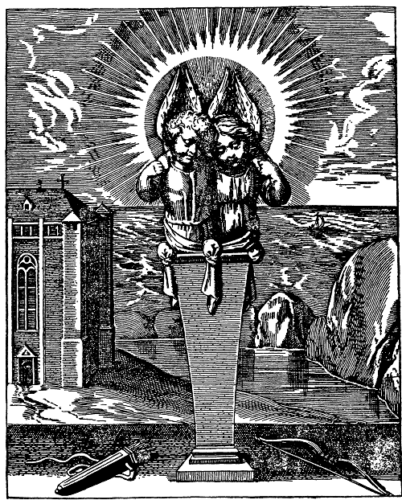
Angels embrace as a couple on the Frontispiece from “The Pillar and Ground of the Truth” by Pavel Florensky.
“The Pillar and Ground of the Truth” explores the meaning of Christian love, especially in “Letter 11: Friendship.” Sanfilippo summarizes the content this way in his article “Conjugal Friendship”:
Florensky’s ideal of friendship as constitutive of “one soul in two bodies,” making of a man’s unique Friend his “other I,” has its roots in the writings of Plato and Aristotle. He traces this theme like a golden thread through Holy Tradition, from David and Jonathan to Christ and John, the pairing of the apostles, the pairing of saints in hagiography and liturgy, the prevalence of monks living in twos in Byzantine and Coptic monasticism, patristic encomiums to friendship that have an almost romantic quality about them, and finally—evolving out of monastic practice and adapted to lay needs—a fully developed rite of brother-making that precedes by a century or two that of marriage.
The adelphopoiesis rite is also the basis of the classic “Same-Sex Unions in Pre-Modern Europe” by historian John Boswell. While Florensky wrote in the Orthodox tradition, 12th-century English saint Aelred of Rievaulx is one of the main theologians of same-sex friendship in the West.
The homoerotic element in “The Pillar and Ground of the Truth” is pointed out by other scholars in addition to Sanfilippo. Slavic professor Richard F. Gustafson describes it in the introduction to Boris Jakim’s English translation of the book:
Florensky’s notion of friendship has a decided homophilic, if not homoerotic, tinge. All dyadic friendships in his discussion are same-sex unions. And this is what is significant theologically, even for our own era. Florensky decenters heterosexual marriage in his presentation of ecclesiality in order to privilege pairs of friends. He moves the discussion of Christian life away from the union of the flesh to the union of the spirit. Marriage is understood as a remnant from pagan life, now blessed by the church; friendship is inherently Christian. To my knowledge, Florensky’s ‘The Pillar and Ground of the Truth’ is the first Christian theology to place same-sex relationship at the center of its vision.
Florensky’s scientific side enabled him to support same-sex couples by using the new scientific concepts of his era. He proposed that the fundamental unit in Christianity is not the individual, which he compared to an atom, but a pair of friends joined like a basic molecule to become “a particle of the Body of Christ.”
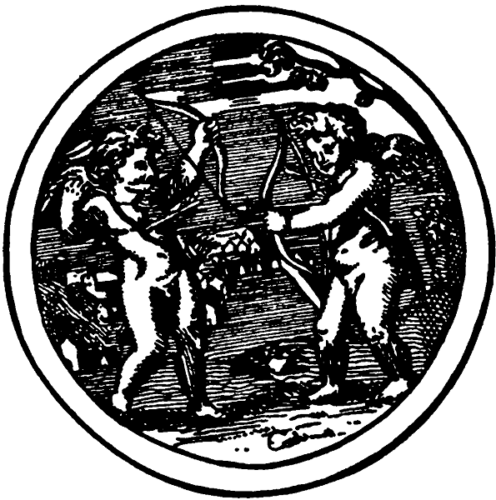
Nude cupids shoot arrows at each other as a male couple in “Happy Battle,” the original illustration for “Letter 11: Friendship” in “The Pillar and Ground of the Truth” by Pavel Florensky.
Same-sex love is affirmed not only in the Florensky’s text, but also by the book’s illustrations. Florensky was an art historian as well as a theologian, so he carefully chose the illustrations and designed the book itself to be a work of art. These images are preserved in the English translation.
The frontispiece at the beginning of the book shows a same-sex pair of angels in a loving embrace. The chapter on friendship goes even further, with an image titled “Happy Battle (Faustum praelium. Бой счастливой.)” Sanfilippo describes it as “an emblem that depicts two naked male cupids playfully shooting at each other with their bows and arrows, one throwing his arms up in a gesture of laughing surrender to the other.”
It is important to point out that Florensky’s theology was not always liberating or innovative. Recent research shows that he even wrote anti-Semitic material under a pseudonym. In his biography, Avril Pyman reminds readers to see Florensky in context as a man of his times whose writing was sometimes “contaminated by the racial terminology of the day in a way that makes it distressing reading in the shadow of the obscenities to be perpetrated against Jews of all persuasions only 20 years thereafter.” Homophobia, anti-Semitism and other forms of bigotry and hate speech often go together, but a few historic church leaders such as Florensky and Bernard of Clairvaux have written daring affirmations of same-sex love while unfortunately sticking to the ugly anti-Semitism of their era.
Florensky’s childhood and teenage conversion
Pavel Alexandrovich Florensky (in Russian Павел Александрович Флоренский) was born Jan. 22, 1882, in Yevlakh, Azerbaijan. His father was a railroad engineer from a family of Russian Orthodox priests, and his mother came from Armenian nobility. He spent most of his childhood in the city of Tbilisi (formerly Tiflis), located in the Caucasus Mountains of Georgia at the crossroads between Europe and Asia.
 A full picture of Florensky’s entire extraordinary life is provided in the first and only English biography of Florensky: “A Quiet Genius: The Tragic and Extraordinary Life of Russia’s Unknown da Vinci” by Avril Pyman (2010). Her book provides most of what English readers know about his friendship with Troitsky.
A full picture of Florensky’s entire extraordinary life is provided in the first and only English biography of Florensky: “A Quiet Genius: The Tragic and Extraordinary Life of Russia’s Unknown da Vinci” by Avril Pyman (2010). Her book provides most of what English readers know about his friendship with Troitsky.
Gifted in math from an early age, he had no religious upbringing but experienced a profound mystical connection to nature. In 1899, the 17-year-old Florensky had a spiritual crisis that led to his religious conversion. He had a dream of being buried by impenetrable darkness through which a thin ray of light or sound brought the name of God. He woke up in shock, crying out, “No, it is impossible to live without God!” Later he became convinced that the spiritual realm was real when he heard a clear voice that could have been either male or female calling him by name.
This conversion experience redirected his life. His immediate family was surprised and embarrassed when he got involved in the church. Florensky studied mathematics at Moscow University, graduating with honors in 1904. He was offered a position on the mathematics faculty, but rejected it to enter seminary.
Florensky bonded with his male friend Sergei Troitsky
Florensky enrolled in the Moscow Theological Academy, which was part of Russia’s most important monastery, Trinity-St. Sergius Monastery (Troitse-Sergiyeva Lavra) in the town of Sergiyev Posad, about 45 miles northeast of Moscow. At seminary he became close friends with fellow student Sergei Semenovich Troitsky (in Russian Сергей Троицкий) (Aug. 8, 1881- Nov. 2, 1910).
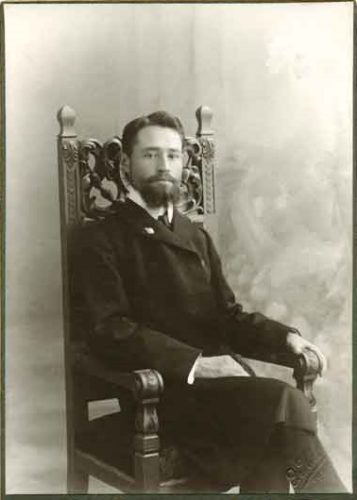
Sergei Troitsky (Courtesy of Giacomo Sanfilippo)
One year ahead of his friend, Troitsky was the son of a country priest from the village of Tolpygino in the Kostroma region of western Russia. The pair shared a dormitory room and dreamed of sharing a contemplative life together in an izba (Russian log hut) deep in the forests of Kostroma, surrounded by books and art.
Their committed relationship is described in slightly different ways by two contemporary writers on LGBTQ spirituality. As Sanfilippo puts it: “The two had planned to spend the rest of their life united in a ‘friendship’ analogous to marriage in nearly every respect but procreation, including the natural need to actualize their spiritual union through some form of bodily expression.”
The couple’s chastity is emphasized by Wesley Hill, author of “Spiritual Friendship: Finding Love in the Church as a Celibate Gay Christian.” His discussion of Florensky in that book states: “When he was still a young adult, he and his friend Sergei, an Orthodox priest’s son, exchanged vows of commitment, pledging fidelity to one another even as they made promises to remain celibate. According to his biographer, Florensky regarded this pact ‘as binding as a marriage or monastic vow.’”
Their dream of a quiet life together as a male couple did not come true. After seminary Troitsky began teaching Russian literature in Florensky’s hometown of Tbilisi, while hoping to enter the priesthood. Typically the Orthodox Church ordains only married men to the priesthood for parish ministry, and in 1909 Troitsky wed Florensky’s younger sister Olga.
Troitsky’s life came to a tragic early end. He was stabbed to death outside his school on Nov. 2, 1910, by an expelled 17-year old student who was a Georgian nationalist and aristocrat. Troitsky’s reported last words were, “I forgive him everything! God be his judge!”
Florensky’s friends knew his aversion to marriage, so they were surprised when he too got married after seminary. In August 1910 he wed Anna Mikhailovna Giatsintova (1889–1973), a teacher from a peasant family and sister of a university friend. They went on to have five children together.
Florensky joined the Moscow Theological seminary faculty and was ordained an Orthodox priest on April 24, 1911. In addition to teaching, he began service as priest in a nearby rural parish.
The memory and fruits of the great friendship between Troitsky and Florensky lives on through “The Pillar and Ground of the Truth,” published in 1914. As Sanfilippo writes, the chapter on friendship “stands as a perpetual testimony to their relationship, its nuptial language and playfully homo-romantic emblem all the more remarkable if we consider that Florensky was a married priest and father of his first child when he prepared ‘Pillar and Ground’ for publication.”
Florensky arrested and executed
Naturally the Russian Revolution of 1917 had a huge impact on Florensky, ushering in a new regime that sought to eliminate all religion. The previous Tsarist government, which was affiliated with the Russian Orthodox Church, was dismantled and replaced with official state atheism by the Soviet Union. Their main target was the Russian Orthodox Church.
The government shut down the Trinity-St. Sergius Monastery in 1918 and Florensky’s church in 1921. Florensky shifted his research interests and began working for the state on electrification, electrical engineering and other scientific subjects. But he still insisted on wearing his clergy cassock and pectoral cross even when he was teaching, working with Soviet scientists and lecturing at science conferences.
Soviet authorities accused him of agitation for comparing the geometry of imaginary numbers to the “kingdom of God” in a paper on Einstein’s theory of relativity. He was briefly arrested in 1928, then released and allowed to continue his scientific work for five more years despite Stalinist purges.
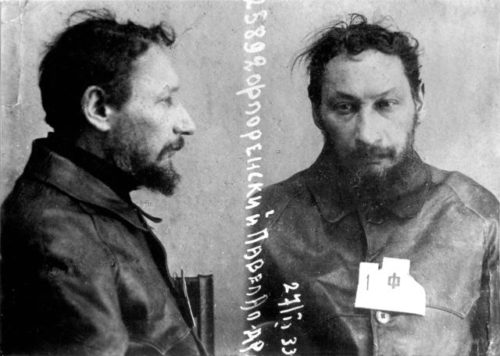
Pavel Florensky, 1933, shortly after his arrest (Wikipedia)
In February 1933 he was arrested on false charges of seeking to overthrow the state and sentenced to 10 years of corrective labor in Siberia. Eventually he was sent to the notorious Solovki gulag, a labor camp in the former Solovetsky Monastery on the White Sea, just below the Arctic Circle. Nevertheless Florensky ministered to fellow prisoners and did scientific research on the local seaweed.
He was sentenced to execution and shot dead on Dec. 8, 1937 at an unknown location near St. Petersburg. His body was probably buried in a mass grave. Florensky was 55.
His individual death was part of a collective tragedy. Almost all Russian Orthodox clergy were shot or imprisoned in the USSR’s anti-religious campaigns from 1929-41. According to Wikipedia, “More than 85,000 Orthodox priests were shot in 1937 alone.”
The Trinity St. Sergius Monastery where Florensky studied with his soulmate Troitsky was reopened in 1946. It continues as a religious center to the present day. Florensky was cleared posthumously with an official “rehabilitation” in 1958-59. The Solovki prison camp where he stayed was re-established as an Orthodox monastery in 1992.
Florensky’s reputation has continued to grow in post-Soviet Russia. There were extensive commemorations for the 70th and 75th anniversaries of his death. Some even consider him a saint and new omartyr, advocating for official recognition from the Russian Orthodox Church.
A memorial tribute published in Paris at the time of Florensky’s death ends with a prayer: “Father Pavel, pray to God for us.”
Controversial new articles on Florensky’s theology of same-sex love
Among those building upon Florensky’s legacy is Giacomo Sanfilippo, a member of the Orthodox Church and a doctoral student in theology at the Trinity College, University of Toronto. His primary research interest is sexual and gender diversity in human and ecclesial life. He serves as an editor at orthodoxyindialogue.com, a blog launched in 2017.
Sanfilippo wrote about Florensky in a set of three articles published between March and July 2017 on the University of Toronto Journals blog and the Public Orthodoxy blog of the Orthodox Christian Studies Center at Fordham University. In the first article he introduces “conjugal friendship,” a term of his own invention, as a theological substitute for “same-sex union.”
The second article explains conjugal friendship with various examples of male-male intimacy from Orthodox tradition, including a 14th-century icon showing warrior-saints Theodore of Tyre and Theodore Stratelates holding hands “like any modern couple.” They were martyred in fourth-century Asia Minor (modern Turkey). The icon is a mural at Holy Transfiguration Monastery in the mountains of Macedonia.
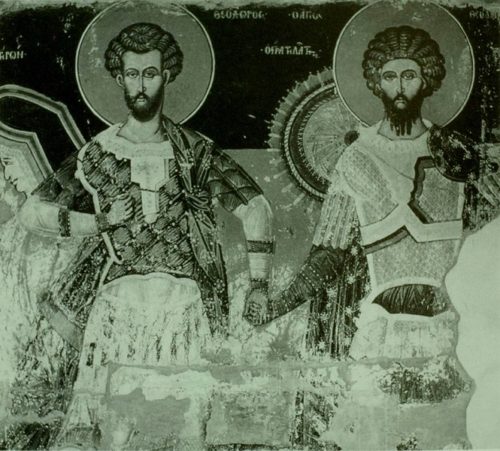
Saints Theodore of Tyre and Theodore Stratelates holding hands. Courtesy of (Giacomo Sanfilippo.)
Sanfilippo’s ideas scandalized some of his Orthodox readers, so the third article summarizes and responds to their criticism. “The firestorm ignited by my article is symptomatic of a deep malaise towards any manifestation of same-sex love at all in traditionalist churches,” he wrote.
While acknowledging the aversion toward same-sex lust in church tradition, Sanfilippo concludes that the saints offer “glimpses into the innate beauty, holiness, and purity of what we now call same-sex love.”
Links related to Pavel Florensky and Sergei Troitsky
“The Pillar and Ground of the Truth” (Столп и утверждение истины) online in original Russian, with images
Conjugal Friendship: The Book by Giacomo Sanfilippo, (orthodoxyindialogue.com, Feb. 7, 2024)
Doctoral Thesis Proposal: “Conjugal Friendship and the Sacrament of Love: Father Pavel Florensky’s Orthodox Theology of Same-Sex Love” by Giacomo Sanfilippo
Excerpts from “Two Worlds,” “Friendship” and “Jealousy” by Pavel Florensky (orthodoxyindialogue.com)
“Erasing Sergei” by Giacomo Sanfilippo (orthodoxyindialogue.com)
A Love Letter to Sergei by Pavel Florensky (orthodoxyindialogue.com)
Memory Eternal: Sergei Semionovich Troitsky (orthodoxyindialogue.com)
“Father Pavel Florensky and the Sacrament of Love” by Giacomo Sanfilippo in The Wheel (spring/summer 2018)
Russian saints and prayers on Q Spirit / Jesus in Love:
Xenia / Andrei of St. Petersburg: Widow adopted husband’s identity and became a queer saint
Pavel Florensky and Sergei Troitsky: Russian theologian of same-sex love and his soulmate
Молитва Радужному Христу (Rainbow Christ Prayer in Russian)
Spiritual art supports Russia’s LGBT rights struggle
___
To read this post in Russian, go to:
Павел Флоренский и Сергей Троицкий: богословие однополой любви (nuntiare.org)
___
Top image credit:
Pavel Florensky, left, and Sergei Troitsky at Moscow Theological Academy, 1906. (Courtesy of Giacomo Sanfilippo.)
Игумен Андроник (Трубачев) [Igumen Andronik (Trubachev)], “П. Флоренский и С. Троицкий во дворе МДА, 1906 [P. Florensky and S. Troitsky in the courtyard of the Moscow Theological Academy, 1906],” Plate 42, in Путь к Богу: Личность, жизнь и творчество священника Павла Флоренского [The Way to God: The Person, Life, and Work of the Priest Pavel Florensky], книга вторая [vol. II] (Сергиев Посад: Фонд науки и православной культуры священника Павла Флоренского, 2015 [Sergiev Posad: Priest Pavel Florensky Foundation for Science and Orthodox Culture, 2015]): between pp. 416-17. Igumen Andronik is Florensky’s grandson.
Other image credits:
Sergei Troitsky:
“С. Троицкий [S. Troitsky], Plate 39, in Путь к Богу: Личность, жизнь и творчество священника Павла Флоренского [The Way to God: The Person, Life, and Work of the Priest Pavel Florensky], книга вторая [vol. II] (Сергиев Посад: Фонд науки и православной культуры священника Павла Флоренского, 2015 [Sergiev Posad: Priest Pavel Florensky Foundation for Science and Orthodox Culture, 2015]): between pp. 416-17. Igumen Andronik is Florensky’s grandson. (Courtesy of Giacomo Sanfilippo.)
Saints Theodore of Tyre and Theodore Stratelates holding hands:
Christopher Walter, “The Sts. Theodore holding hands. Zrze, Macedonia,” Plate 41, in The Warrior Saints in Byzantine Art and Tradition (Burlington, VT: Ashgate Publishing Company, 2003): between pp. 144-45. (Courtesy of Giacomo Sanfilippo.)
___
This post is part of the LGBTQ Saints series by Kittredge Cherry. Traditional and alternative saints, people in the Bible, LGBTQ martyrs, authors, theologians, religious leaders, artists, deities and other figures of special interest to lesbian, gay, bisexual and transgender and queer (LGBTQ) people and our allies are covered.
This article was originally published on Q Spirit in August 2017, was expanded with new material over time, and was most recently updated on Dec. 7, 2024, 2023.
Copyright © Kittredge Cherry. All rights reserved.
Qspirit.net presents the Jesus in Love Blog on LGBTQ spirituality.



















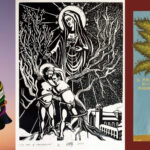
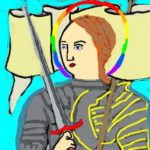
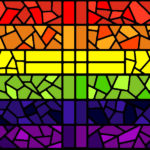
A simple and gracious thank you for this beautiful and enlightening article on same sex love. Homophobia is rampant in religion today and will never accept the theological construction of same sex love. But I do. I have been with my partner for 25 years and can’t begin to tell the amount of joy and happiness our same sex love brings to our lives. Hail, Mr. Florensky, Saint and Martyr for all times.
So once again, there isn’t a single bit of evidence indicating any romance between the two people in question, hence this is another case where someone merely described a friendship which one modern author has conflated with same-sex romance using Boswell’s discredited ideas, which have been debunked even by gay historians such as Alan Bray as well as other mainstream historians. But you’re describing Florensky as a gay theologian who justified same-sex intercourse / marriage although he did nothing remotely of the type.
It seems that same sex love and marriage is not some kind of “Johnny come lately/politically correct” issue of nowadays but has been around for a VERY LONG TIME. Of all the saints in the Church(Orthodox, Roman Catholic, Greek Catholic of the Byzantine rite et al) it defies the law of probability that they could ALL be heterosexual(“straight” in secular parlance)
I am always shocked whenever humanity reduces God to a spiritual entity whose main concern is WHO and HOW we love and not as the God of love who LOVES that we love. How very sad. In my heart of hearts, I know that my relationship has been ordained by God. Absent my love of Christ and the Trinity, nothing has brought such joy and love to my soul. My wish for all of you is that you experience such love in your own lives. To love and be loved as I have and am is to know God. After almost 40 years, the physical or sexual, if you will, aspect of this marriage of our souls is no longer important. What remains is a deep and abiding love, one for the other, that surpasses the psychical. To diminish this gift from God is to diminish God.
Please stop looking at Christia traditions through your own, XXIst century-lgbt eyes or you will remain blind to what is reality of Christ’s church and what God says in his own Words. Troitsky, Florensky, Orthodoxy, Christ himself and his Apostles nowhere and never ever accept homosexual sexual acts, and they wont. Otherwise, they would say clearly that love is love and to love is the most important thing regardless if its hetero or homo. What Christ actually says in commandment of love is “You shall love the Lord your God with all your heart and with all your soul and with all your mind. This is the great and first commandment. And a second is like it: You shall love your neighbor as yourself. On these two commandments depend all the Law and the Prophets.”
— Matthew 22:35-40
So it is not about love as a relationship between two people: its firstly love to God and the way He loves Us, and then love to other people. Who loves God, obeys his commandments and doesnt sin. Troitsky and Florensky have nothing to do with sin of homosexuality (romantic relationship in a way as it is between wife and husband), and the importance of freindship, also same-sex (as it was something unusual) is quite common between catholic and orthodox saints.
A simple “Thank you” for this work and teaching.
Re spirit and soul,if we look at this esoterically, the soul or body electric is what sustains the body in existence, even that of animals – the animal soul or nephesh is accepted as a reality within Judaism, indeed the bible itself. Animals don’t however have spirit which is what is more directly related to God and involved in especially prayer.
Persons become “one flesh” when the auras/souls blend, not when spirits blend though the spirit can be indirectly affected which is doubtless why St Paul is so concerned among his Corinthians that they will not make themselves of “one flesh” with prostitutes. This is because it is an offence against God and relating to Holy Spirit and the union in effect amounts to a marriage.
In the “Beyond Marriage Equality” essay I referred to in the last message, I cite the case of a lesbian Christian who alleged a vision of Jesus from which she understood things about herself and sex and that despite the seeming improbability of it, same sex partners could become one flesh. Because the woman plainly did not understand the esoterics of this she didn’t realize that of course the same sex couple can become as one like any heterosexual couple because the oneness is always through the blending of the auras when there is full orgasm with sufficient penetration or proximity. It is incidentally the case that those who claim to be able to see auras (it’s quite likely the way Jesus saw people and how he read their minds and motives) maintain that promiscuous people have muddied, discoloured auras. It is not possible to keep being in union with people through full penetrative orgasm without affects on the whole body electric. The situation is one that overall would seem to recommend a generally speaking more “tantric” approach to sex along the lines indicated by Part Two of my article and my “Solomon’s Tantric Song” book. Western attitudes to sex are far too athletic and materialistic and lack adequate mystical dimension and this is ultimately damaging.
We undoubtedly view these figures through 21st century eyes and with our own cultural perspectives. People for whom “the love of their lives” was someone of the same gender still had to live in the context of the societal norms and “givens” of their time and place. (This is still true in many places.) So it’s not at all odd that Florensky married and produced five children. He probably loved them and probably had an affection for their mother. It was and is not uncommon. I sang at a wedding once– the groom was a Chinese man who was the partner of a male friend of mine. The two were very much “together” as a same sex couple. Suddenly I was asked to sing at the wedding of the Chinese partner. His parents had said “It’s time to marry and give us a grandchild.” He obeyed — it was (in his estimation) his “only” cultural choice. The new bride and groom lived in a back apartment of where the groom had been living with his lover. (I should add that it didn’t last– but that’s another story.) In countries and places where being with your same-sex partner would put your life in danger, people “adjust.” We could say– “Love finds a way.” One could add that “Love leads the way.” And I dare say that Divine Love always finds a way. It certainly did for my partner and me– for 44 blessed years before he passed away almost three years ago from a rare cancer. One feels incomplete navigating the world alone– until you realize that you are not alone. Love never dies. In the meanwhile, human beings make silly games of celibacy. People love to resort to junior high school queries and questions that amount to “I wonder if they’re doing ‘it’?” Being “one soul” is also not always determined by whether or not there is a coital consumption of the same. If the physical– sexual expression– is part of being “one soul”– all the more a blessing. I am reminded of the wonderful play “BENT” — a love story between two men in a concentration camp who are both restrained but who fall in love and have a very sexual relationship without ever touching. A powerful drama and food for thought– The icon of the two saints Theodore holding hands is splendid. I like to imagine that in the next scene they kiss and one says he’s going to get things ready for mass and “I’ll see you at home later.” In the meanwhile we live in a world that creates new words like “Bromance” partly as a bone-fide description of affection between two males. But partly irritating because — like a “bro-hug” there’s an “qualifier” element that’s meant to explain that “we’re not gay.” And interestingly enough we don’t have an equivalent word for two women. That fact in itself is “sexist.” And Florensky “bonded” with his male friend. Bonded is another interesting word. And Jesus bonded with Lazarus– omg– (literally omg) I bet they never did a bro-hug. I’m sure their hug was a good ole affectionate unqualified embrace.
An interesting and important story. However, having checked with wiki that 22nd Jan was indeed the correct New Style date (OS was 9th Jan), I found pretty much what I expected to find even without having a birth time and thus a full chart pattern.
Florensky was a text book Aquarian in being an original, bright and ahead of his times, sometimes a bit of rebel against the status quo. But I do question whether he was truly gay – if he could marry and have five children plainly he was no typical same sex lover but rather bisexual. I have long insisted that the basic building block to a bisexual profile is a stressed, so-called “afflicted” Neptune and sure enough we find Neptune at 13 Taurus (and conjunct Jupiter so all effects are magnified into super romanticism) easily within “square” (i.e 90 degrees) Mercury at 11 Aquarius.
I wonder if Florensky proved severe with his spouse as many bisexual men (including David with Michal, Saul’s daughter) can be. Whatever their orientation, with Neptune square Mercury, which could be good for crime writing, typically the person often fails to see things right and may bend the truth – an affliction means what it says; there is some kind of difficulty to watch out for and determine to manage if real trouble is to be avoided.
I don’t think it was really quite right, though doubtless it was necessary to say something of the sort at the time, to suggest the two can become one spirit; the esoteric reality is rather that they can become one soul and once this is realized it is possible to go beyond a situation of complete and total celibacy. I can’t obviously discuss all this here but some idea of these insufficiently recognized perspectives is contained in my two part essay “Beyond Marriage Equality” at this address http://wp.me/p6Zhz7-m
Rollan, thanks for your astrological reading on Florensky and the link to your “Beyond Marriage Equality” piece. It would be interesting to know Troitsky’s horoscope too, but I had a very hard time just finding his birth year! I didn’t find much info on how he treated his wife either. But his children and grandchildren are helping to preserve his legacy now.
Your distinction between soul and spirit seems helpful, and it’s intriguing to think that becoming “one soul” makes sexual relations possible. I suppose that applies to heterosexuals too?